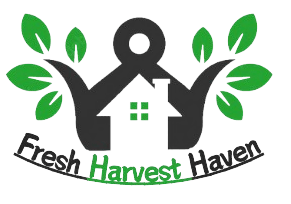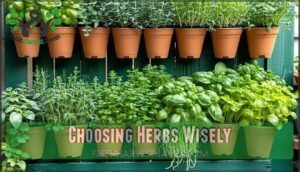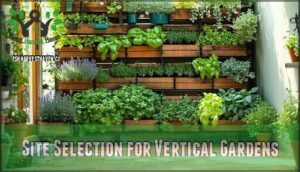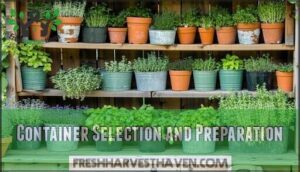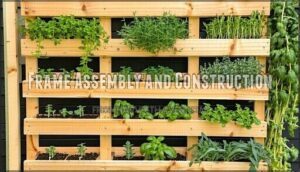This site is supported by our readers. We may earn a commission, at no cost to you, if you purchase through links.
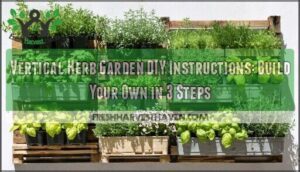
Start by selecting a sunny wall space and choosing compact herbs like basil, thyme, and oregano that thrive vertically.
Create your structure using materials you likely have around—old gutters work perfectly as planters, then mount everything securely, fill with quality potting soil, and plant your herbs leaving space for growth.
The beauty of going vertical isn’t just saving space; it’s creating an edible wall that puts fresh flavors at arm’s reach while transforming any boring surface into a living masterpiece that practically harvests itself.
Table Of Contents
- Key Takeaways
- Vertical Garden Basics
- Choosing Herbs Wisely
- Garden Setup Essentials
- Building Vertical Gardens
- Maintenance and Care Tips
- Frequently Asked Questions (FAQs)
- What is a DIY vertical herb garden?
- Can you make a vertical herb planter?
- How do you grow herbs in a vertical garden?
- How do you make a small herb garden?
- How do you make a vertical garden?
- What is a vertical herb garden?
- Can you grow herbs in a vertical garden?
- How to make a vertical garden step by step?
- What are the disadvantages of vertical gardens?
- Are there any drawbacks to using vertical gardens?
- Conclusion
Key Takeaways
- You’ll maximize small spaces by building upward using simple materials like wooden pallets, gutters, or repurposed containers, creating productive herb gardens that save 50% more space than traditional methods.
- Choose shallow-rooted herbs like basil, thyme, oregano, and mint that thrive in compact vertical containers with 6-8 hours of daily sunlight and well-draining potting soil.
- Build your structure with basic materials you likely have around—mount securely to walls, ensure proper drainage holes, and space plants according to their mature size to prevent overcrowding.
- Maintain your garden by checking soil moisture regularly (finger-test method), harvesting frequently using the one-third rule, and troubleshooting common issues like root rot from poor drainage or pest problems in cramped spaces.
Vertical Garden Basics
You can transform any small space into a thriving herb garden by building upward instead of outward.
Creative vertical gardens use everything from repurposed spice racks to hanging gutters, turning ordinary walls into productive growing spaces that look amazing too.
Unique Vertical Garden Ideas
Since you’re working with limited space, vertical herb gardens transform any wall into a productive growing area.
These creative DIY solutions maximize your growing potential:
- Hanging Shelf gardens: Drill holes in pine boards to hold terra-cotta pots
- Metal Containers: Repurpose ammunition boxes or mailboxes with chain suspension
- Spice Racks: Mount white wire racks as instant vertical planters
- Pipe Planters: Create industrial-style displays with galvanized materials
Paint cans add colorful flair while spacesaving designs boost your harvest by 50%.
Creative Vertical Garden Displays
Let’s spice up your vertical herb garden with creative solutions that turn ordinary spaces into green masterpieces.
DIY herb garden projects using unique materials like repurposed spice racks or hanging file organizers create stunning aesthetic arrangements.
Artistic integration meets space optimization when you transform everyday items into thematic gardens.
Vertical gardening also helps with improving airflow around plants, which reduces the risk of diseases.
| Display Type | Materials Used |
|---|---|
| Industrial Chic | Metal gutters, chains |
| Rustic Charm | Wooden pallets, rope |
| Modern Minimalist | Wire racks, clean lines |
| Upcycled Creative | Paint cans, shoe organizers |
| Garden Classic | Terra-cotta pots, natural wood |
Inspirational Vertical Gardens
Anyone can transform mundane spaces into stunning urban oasis displays with creative vertical garden ideas.
These living walls become garden art that turns balconies into green sanctuaries.
Consider these inspiring DIY herb garden approaches:
- Painted bucket cascade: Bright containers on wooden trellises create colorful patio designs
- Spice rack transformation: Wire racks become elegant herb garden design features
- Leaning bucket garden: S-hooks and buckets add rustic charm for small space gardening
Repurposed Materials for Vertical Gardens
Transforming trash into treasure, your vertical herb garden design thrives with clever upcycling.
These DIY garden projects slash costs by 50-80% while reducing waste:
Spice rack planters and bottle vertical gardens prove that repurposing everyday items creates stunning vertical garden ideas.
This approach aligns with the growing trend of sustainable gardening solutions.
Choosing Herbs Wisely
Not all herbs are created equal in terms of vertical growing success.
You’ll want to focus on varieties with shallow root systems and compact growth habits that thrive in containers rather than sprawling ground covers.
Plants for Vertical Gardens
Smart plant selection makes your vertical planter DIY project flourish. Consider root depth, sunlight needs, and watering frequency when choosing herbs for your indoor herb garden or outdoor setup.
Right plants in right spots equal thriving vertical gardens every time.
- Shallow-rooted champions like basil and chives thrive in compact spaces
- Sun-loving powerhouses such as rosemary and thyme maximize visual appeal
- Shade-tolerant varieties including mint and parsley adapt to lower light
- Pest-resistant heroes like lavender naturally repel unwanted garden visitors
To optimize growth, consider grouping similar herbs together.
Herb Selection and Planting
Smart herb selection starts with understanding herb compatibility—some plants make great neighbors, while others compete for resources.
Match sunlight needs carefully; basil craves full sun, but parsley tolerates partial shade.
Choose container size based on root depth; shallow-rooted culinary herbs like thyme work perfectly in compact spaces.
Your soil type should drain well yet retain moisture.
Planting techniques matter too—space plants according to their mature size to prevent overcrowding in your vertical planter DIY.
Herb planting success depends on matching each variety’s specific growing requirements.
Suitable Herb Types
Picking the perfect herbs makes all the difference in your vertical garden’s success. Mint Varieties like spearmint and peppermint pack powerful flavor but need separate containers since they’re aggressive spreaders.
Basil Cultivars including sweet basil and Thai basil love warm spots and frequent harvesting. Parsley Types offer flat-leaf and curly options that keep producing all season.
Here’s your herb selection starter pack:
- Compact culinary herbs: Choose Thyme Options like lemon thyme for small spaces
- Annual herbs: Plant cilantro and dill for quick, continuous harvests
- Perennial powerhouses: Rosemary Care requires good drainage but rewards you year-round
This herb growth strategy guarantees you’ll have fresh flavors within arm’s reach.
Garden Setup Essentials
Once you’ve selected your ideal herbs, you’ll need to set up your vertical garden properly to promote healthy growth.
The foundation of any successful vertical herb garden starts with choosing the right location, containers, and soil mix.
Site Selection for Vertical Gardens
Finding the right location for your vertical herb garden is vital for success.
Your garden’s success starts with choosing the perfect sunny spot that gets 6-8 hours of daily light.
You’ll want to scout several spots throughout the day to understand how sunlight moves across your space.
Here are three essential factors to evaluate:
- Sunlight Exposure – Your herbs need 6-8 hours of direct sunlight daily for ideal growth and flavor development
- Drainage Needs – Choose areas where water won’t pool, preventing root rot and plant failure
- Space Availability – Verify adequate room for your structure plus easy access for daily care
Consider microclimate factors like wind protection and heat reflection from nearby walls.
Accessibility matters too – you’ll harvest more often when herbs are conveniently located near your kitchen.
Vertical gardening works well in limited space situations, but proper site selection determines whether your herb cultivation thrives or merely survives.
Container Selection and Preparation
Your container choice sets the foundation for healthy herb growth.
Container Materials like terracotta offer excellent breathability, while plastic retains moisture longer—both work great with proper Drainage Solutions.
Always drill holes to prevent waterlogged roots that kill herbs fast.
For ideal results, consider specialized drainage products designed to prevent root rot.
Size Considerations matter: compact herbs like thyme thrive in smaller spaces, but mint needs room to spread.
For vertical gardening ideas, repurpose paint cans, spice racks, or shoe organizers for unique DIY projects.
Wire containers need Liner Options like landscape fabric to retain soil while allowing drainage.
Match your garden containers to both style preferences and herb cultivation needs for successful container gardening herbs.
Soil Preparation for Vertical Gardens
Once you’ve selected your containers, you’ll need the right foundation for healthy growth. Quality potting mix beats garden soil every time for container gardening herbs—it’s lighter and drains better.
Here’s your soil prep checklist for vertical gardening ideas:
- Choose well-draining soil mixed with organic matter
- Add soil amendments like compost for nutrient balance
- Include perlite or vermiculite to prevent soil compaction
- Test soil moisture retention with different watering techniques
- Install proper drainage solutions in each container
Don’t skimp on quality here—your herbs will reward good soil prep with robust growth and flavor!
Building Vertical Gardens
Now you’re ready to turn your vertical garden vision into reality.
Building your own structure gives you complete control over size, materials, and design while keeping costs reasonable compared to store-bought options.
Frame Assembly and Construction
While building your wooden frame might seem challenging, it’s actually the most rewarding part of creating your vertical garden. Start with leg assembly by cutting your cedar boards to size and connecting them with deck screws. Next comes shelf installation – secure each level using proper spacing for your chosen herbs.
Cleat placement guarantees everything stays rock-solid, while back slatting provides vital plant support. Vertical gardening also helps with improving airflow, which is great for plant health.
Don’t forget sealer application to protect your investment from weather damage. Your trellis wood becomes the backbone, and adding sisal rope with dock cleat hangers creates flexible growing zones.
- Position S hooks strategically for hanging planters that catch morning light
- Install cleats every 8 inches to distribute weight evenly across the frame
- Use galvanized screws to prevent rust stains on your beautiful cedar
- Create removable shelf sections for easy seasonal plant rotation
- Add drainage holes in each shelf to prevent waterlogged roots
Planter Box and Installation
After your frame’s in place, it’s time to craft planter boxes that’ll transform your space saving garden into a herb haven.
Choose cedar boards for Material Selection—they resist rot better than pine. For Box Dimensions, aim for 6-8 inches deep to accommodate herb roots.
Create Drainage Solutions by drilling multiple holes, then line with landscape fabric. Consider compact gardening solutions for smaller areas.
Use corner brackets for Weight Distribution and secure Mounting Techniques with deck screws for your wall mounted garden stability.
Using Commercial Vertical Garden Options
When you’re short on time or carpentry skills, pre-made systems offer a smart shortcut to vertical gardening success.
These modular components snap together like adult LEGOs, transforming your kitchen herb garden dreams into reality without the sawdust.
Here are five commercial options worth considering:
- Wall mounted garden towers with automated watering systems that feed your herbs while you’re away
- Hanging herb garden kits featuring integrated lighting for year-round growing indoors
- Space saving garden planters with stackable designs perfect for apartment balconies
- Self-watering garden planters that eliminate guesswork and prevent both drought and drowning
- Modular hydroponic systems offering professional results with minimal maintenance
Before buying, run a cost analysis comparing DIY versus commercial options.
You can find a wall garden tower online for easy setup.
While store-bought systems cost more upfront, they often include warranties and customer support.
Think of it as insurance for your green thumb – sometimes paying extra for peace of mind beats wrestling with wonky homemade contraptions.
Maintenance and Care Tips
Once your vertical herb garden is built and planted, proper maintenance keeps it thriving throughout the growing season.
You’ll need to stay on top of watering, pruning, and troubleshooting to enjoy fresh herbs all year long.
Regular Watering and Soil Moisture
Now that your vertical garden structure is complete, keeping your herbs properly hydrated becomes your next priority.
Think of watering as feeding a friendship – too much attention smothers, too little kills the relationship.
Master moisture monitoring by sticking your finger into the soil.
Well-draining soil should feel like a wrung-out sponge – damp but not soggy.
Overwatering signs include yellowing leaves and musty odors, while underwatering symptoms show as wilted, crispy foliage.
Your herb watering success depends on soil drainage and moisture retention balance, not rigid schedules.
This balance is crucial for maintaining healthy herbs, and it requires careful attention to the moisture retention of the soil.
Harvesting and Pruning Herbs
With proper watering in place, you’ll want to harvest regularly to keep your herbs producing.
Sharp scissors or pruning shears work best for clean cuts that promote bushier growth.
Morning harvesting techniques capture peak flavor enhancement when essential oils are strongest.
Follow the one-third rule—never take more than that amount at once.
Pruning frequency should be weekly for fast growers like basil, while slower herbs need bi-weekly attention.
To avoid issues such as root rot, make certain you’re following watering frequency tips.
This encouraging growth approach keeps your vertical garden thriving all season long.
Troubleshooting Common Issues
Even with good harvesting habits, herb garden challenges pop up.
Root rot strikes when drainage problems create soggy soil—check for mushy stems and yellowing leaves.
Sunlight issues cause weak, leggy growth, so verify six hours of direct light daily.
Pest control matters: aphids love cramped vertical planters.
Nutrient deficiency shows as pale leaves needing monthly feeding.
These gardening tips herbs keep your troubleshooting simple and plants thriving.
Frequently Asked Questions (FAQs)
What is a DIY vertical herb garden?
Crafting clever containers creates space-saving solutions for your kitchen herbs.
You’ll build upward-growing gardens using repurposed materials like pallets, gutters, or household items, maximizing limited space while keeping fresh herbs within easy reach, utilizing space-saving solutions and upward-growing gardens.
Can you make a vertical herb planter?
You absolutely can make a vertical herb planter using simple materials like wooden boards, gutters, or repurposed containers. It’s an easy DIY project that maximizes growing space.
How do you grow herbs in a vertical garden?
Just like morning dew finds every leaf, you’ll select herbs with shallow roots like basil, mint, and thyme.
Plant them in well-draining containers, ensuring six hours of sunlight daily for thriving growth.
How do you make a small herb garden?
Start with quality containers filled with well-draining potting mix. Choose herbs like basil, parsley, and mint that thrive in small spaces. Position in sunny spots and water regularly.
How do you make a vertical garden?
Build a frame from wood boards, attach horizontal shelves or planters at different levels, and mount it against a wall or fence.
You’ll need basic tools, screws, and containers for your plants to create this space-saving garden solution, which is a complete concept for improving your garden.
What is a vertical herb garden?
Your space-saving solution transforms any wall into a living pantry.
A vertical herb garden grows herbs upward instead of outward, maximizing small spaces like balconies or patios using shelves, pockets, or hanging containers.
Can you grow herbs in a vertical garden?
Yes, you can absolutely grow herbs in vertical gardens.
They’re perfect since herbs have shallow roots and don’t need deep soil.
You’ll harvest fresh basil, mint, parsley, and thyme easily while maximizing your growing space efficiently.
How to make a vertical garden step by step?
Don’t reinvent the wheel—start with cedar boards, drill holes, and screw together shelves. Cut legs, attach cleats, mount back slats, then add your herb containers for easy harvesting.
What are the disadvantages of vertical gardens?
You’ll face higher water consumption, potential weight issues that strain walls, limited plant variety due to shallow soil, frequent maintenance needs, and possible drainage problems causing root rot.
Are there any drawbacks to using vertical gardens?
Vertical gardens aren’t quite the maintenance-free dream they appear.
You’ll wrestle with watering challenges, limited root space, and potential structural issues.
Weight concerns and uneven moisture distribution can turn your green oasis into a gardening headache.
Conclusion
Surprisingly, vertical herb gardens actually outperform traditional gardens in herb production per square foot.
Your vertical herb garden diy instructions don’t require special skills or expensive materials—just creativity and weekend determination.
You’ll enjoy fresh basil in January, oregano year-round, and herbs that stay cleaner than ground-level gardens.
Within weeks, you’ll wonder why you waited so long to go vertical.
Your kitchen will thank you, and your neighbors will definitely ask for advice.
- https://www.gardenersoasis.com/diy-vertical-garden-ideas/
- https://dug.org/gardening-resources/vertical-growing/
- https://www.goodhousekeeping.com/home/gardening/g40736540/vertical-garden-ideas/
- https://coastcontainers.ca/blog/shipping-container-gardens-a-unique-approach-to-urban-farming
- https://green.org/2024/01/30/upcycled-materials-for-diy-vertical-gardens/
